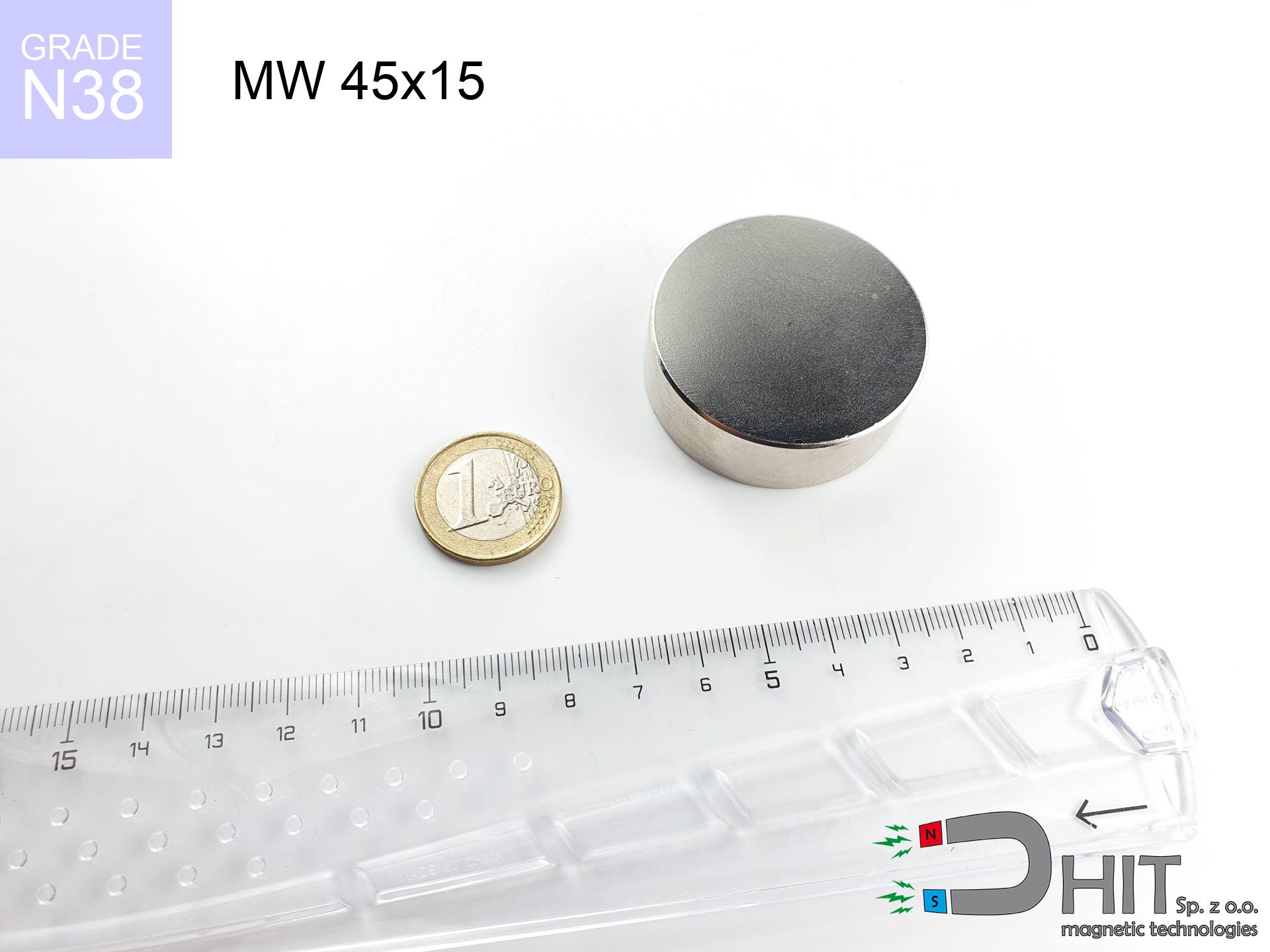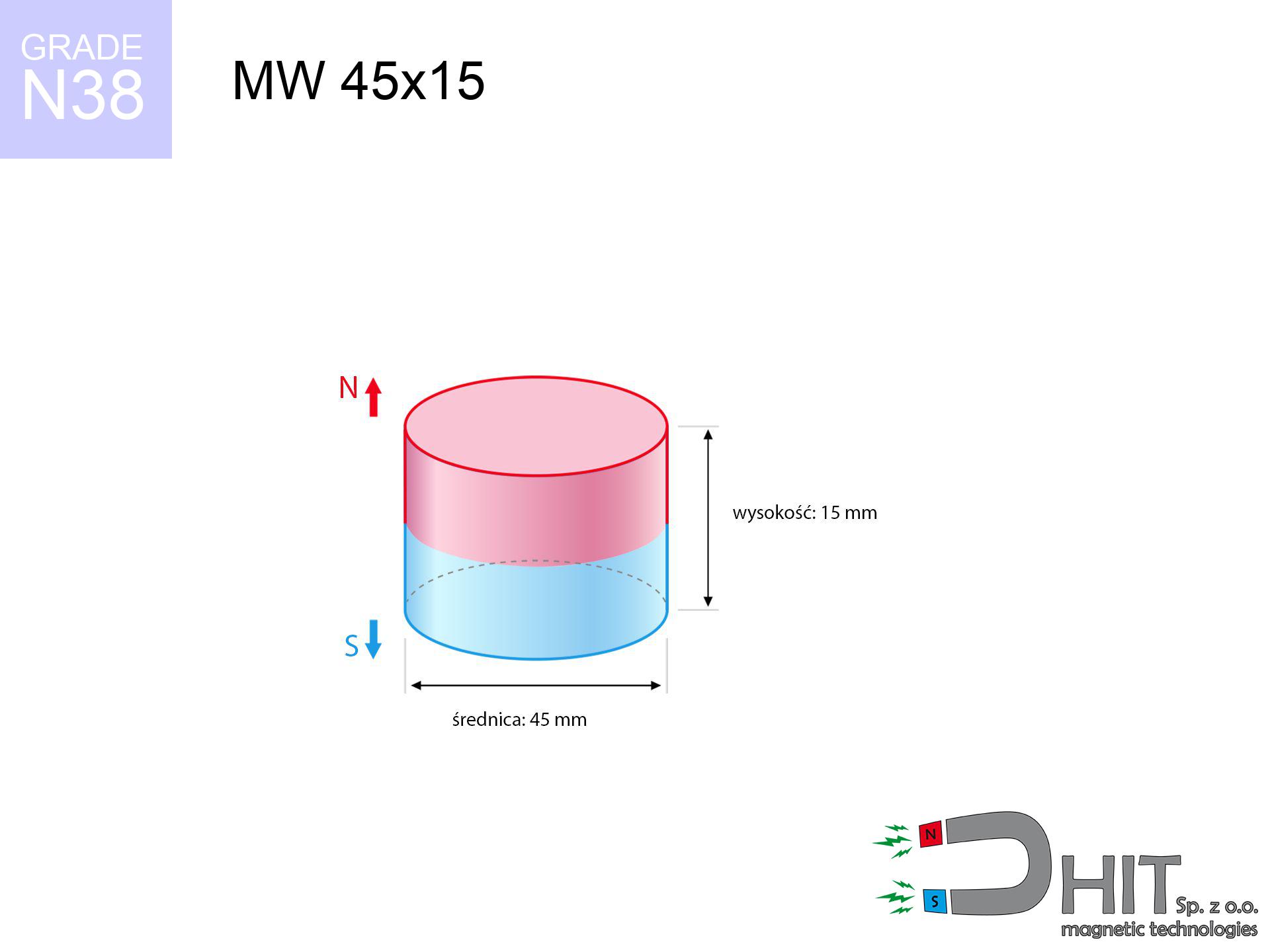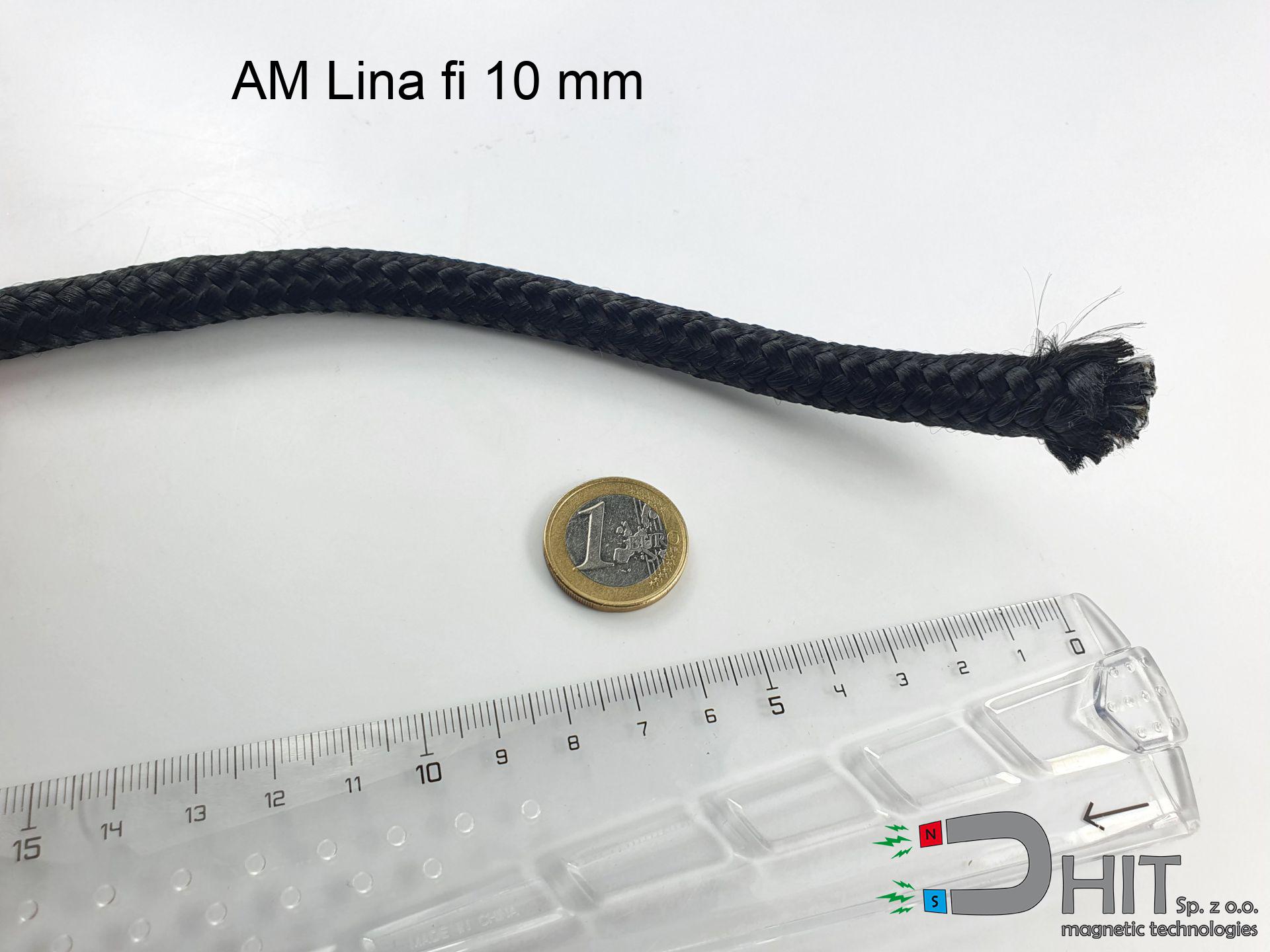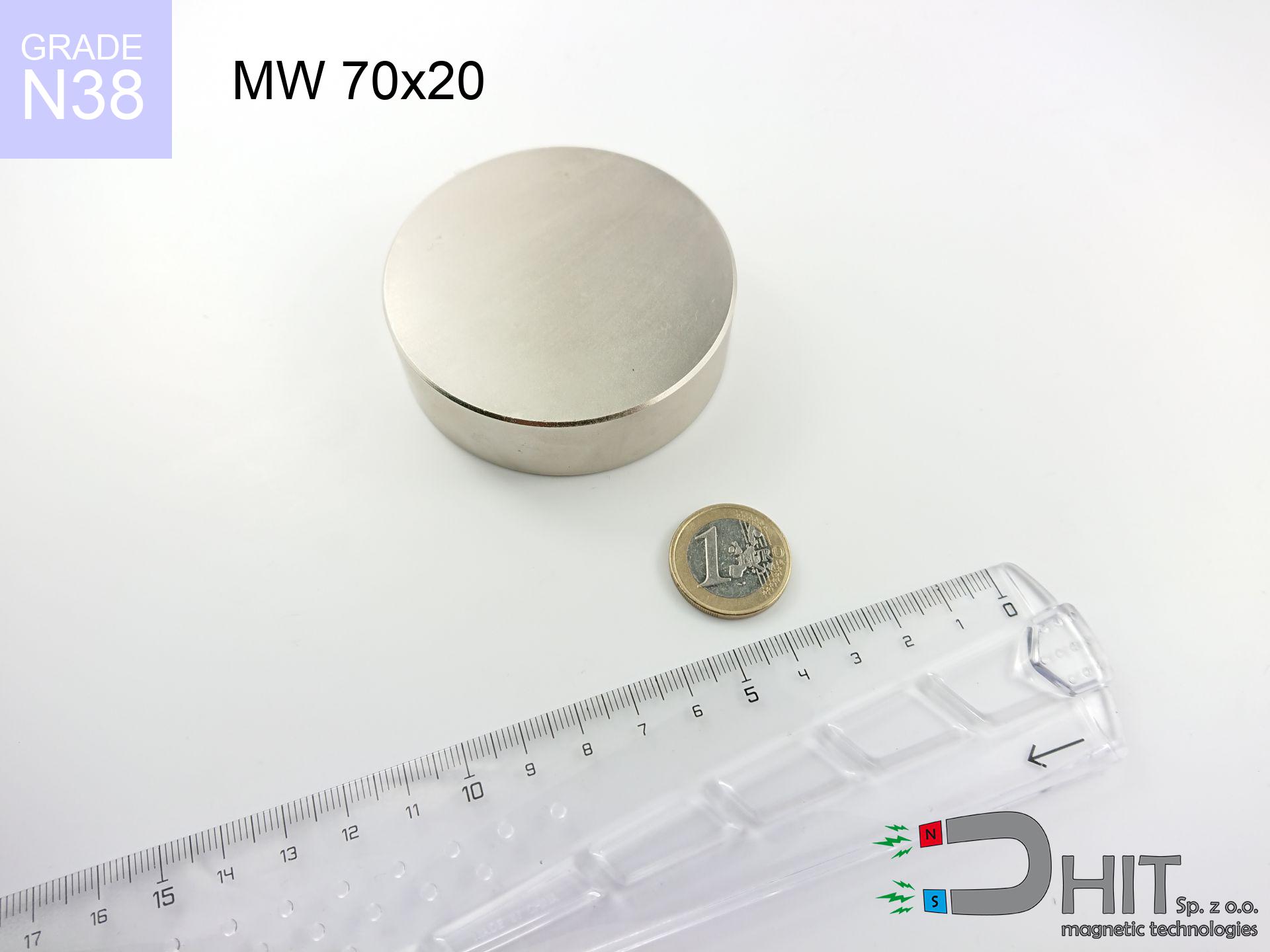MW 45x15 / N38 - cylindrical magnet
cylindrical magnet
Catalog no 010070
GTIN/EAN: 5906301810698
Diameter Ø
45 mm [±0,1 mm]
Height
15 mm [±0,1 mm]
Weight
178.92 g
Magnetization Direction
↑ axial
Load capacity
48.55 kg / 476.32 N
Magnetic Induction
343.84 mT / 3438 Gs
Coating
[NiCuNi] Nickel
61.84 ZŁ with VAT / pcs + price for transport
50.28 ZŁ net + 23% VAT / pcs
bulk discounts:
Need more?Can't decide what to choose?
Pick up the phone and ask
+48 888 99 98 98
if you prefer contact us through
our online form
the contact section.
Parameters as well as structure of magnets can be estimated on our
power calculator.
Same-day processing for orders placed before 14:00.
MW 45x15 / N38 - cylindrical magnet
Specification / characteristics MW 45x15 / N38 - cylindrical magnet
| properties | values |
|---|---|
| Cat. no. | 010070 |
| GTIN/EAN | 5906301810698 |
| Production/Distribution | Dhit sp. z o.o. |
| Country of origin | Poland / China / Germany |
| Customs code | 85059029 |
| Diameter Ø | 45 mm [±0,1 mm] |
| Height | 15 mm [±0,1 mm] |
| Weight | 178.92 g |
| Magnetization Direction | ↑ axial |
| Load capacity ~ ? | 48.55 kg / 476.32 N |
| Magnetic Induction ~ ? | 343.84 mT / 3438 Gs |
| Coating | [NiCuNi] Nickel |
| Manufacturing Tolerance | ±0.1 mm |
Magnetic properties of material N38
| properties | values | units |
|---|---|---|
| remenance Br [min. - max.] ? | 12.2-12.6 | kGs |
| remenance Br [min. - max.] ? | 1220-1260 | mT |
| coercivity bHc ? | 10.8-11.5 | kOe |
| coercivity bHc ? | 860-915 | kA/m |
| actual internal force iHc | ≥ 12 | kOe |
| actual internal force iHc | ≥ 955 | kA/m |
| energy density [min. - max.] ? | 36-38 | BH max MGOe |
| energy density [min. - max.] ? | 287-303 | BH max KJ/m |
| max. temperature ? | ≤ 80 | °C |
Physical properties of sintered neodymium magnets Nd2Fe14B at 20°C
| properties | values | units |
|---|---|---|
| Vickers hardness | ≥550 | Hv |
| Density | ≥7.4 | g/cm3 |
| Curie Temperature TC | 312 - 380 | °C |
| Curie Temperature TF | 593 - 716 | °F |
| Specific resistance | 150 | μΩ⋅cm |
| Bending strength | 250 | MPa |
| Compressive strength | 1000~1100 | MPa |
| Thermal expansion parallel (∥) to orientation (M) | (3-4) x 10-6 | °C-1 |
| Thermal expansion perpendicular (⊥) to orientation (M) | -(1-3) x 10-6 | °C-1 |
| Young's modulus | 1.7 x 104 | kg/mm² |
Engineering simulation of the product - technical parameters
Presented data represent the direct effect of a engineering simulation. Values rely on algorithms for the class Nd2Fe14B. Real-world parameters might slightly differ. Please consider these calculations as a supplementary guide for designers.
MW 45x15 / N38
| Distance (mm) | Induction (Gauss) / mT | Pull Force (kg) | Risk Status |
|---|---|---|---|
| 0 mm |
3438 Gs
343.8 mT
|
48.55 kg / 48550.0 g
476.3 N
|
critical level |
| 1 mm |
3318 Gs
331.8 mT
|
45.21 kg / 45214.3 g
443.6 N
|
critical level |
| 2 mm |
3189 Gs
318.9 mT
|
41.76 kg / 41762.8 g
409.7 N
|
critical level |
| 3 mm |
3054 Gs
305.4 mT
|
38.30 kg / 38303.2 g
375.8 N
|
critical level |
| 5 mm |
2774 Gs
277.4 mT
|
31.61 kg / 31610.0 g
310.1 N
|
critical level |
| 10 mm |
2090 Gs
209.0 mT
|
17.95 kg / 17948.5 g
176.1 N
|
critical level |
| 15 mm |
1521 Gs
152.1 mT
|
9.50 kg / 9500.8 g
93.2 N
|
strong |
| 20 mm |
1096 Gs
109.6 mT
|
4.94 kg / 4936.3 g
48.4 N
|
strong |
| 30 mm |
585 Gs
58.5 mT
|
1.41 kg / 1407.9 g
13.8 N
|
safe |
| 50 mm |
205 Gs
20.5 mT
|
0.17 kg / 172.6 g
1.7 N
|
safe |
MW 45x15 / N38
| Distance (mm) | Friction coefficient | Pull Force (kg) |
|---|---|---|
| 0 mm | Stal (~0.2) |
9.71 kg / 9710.0 g
95.3 N
|
| 1 mm | Stal (~0.2) |
9.04 kg / 9042.0 g
88.7 N
|
| 2 mm | Stal (~0.2) |
8.35 kg / 8352.0 g
81.9 N
|
| 3 mm | Stal (~0.2) |
7.66 kg / 7660.0 g
75.1 N
|
| 5 mm | Stal (~0.2) |
6.32 kg / 6322.0 g
62.0 N
|
| 10 mm | Stal (~0.2) |
3.59 kg / 3590.0 g
35.2 N
|
| 15 mm | Stal (~0.2) |
1.90 kg / 1900.0 g
18.6 N
|
| 20 mm | Stal (~0.2) |
0.99 kg / 988.0 g
9.7 N
|
| 30 mm | Stal (~0.2) |
0.28 kg / 282.0 g
2.8 N
|
| 50 mm | Stal (~0.2) |
0.03 kg / 34.0 g
0.3 N
|
MW 45x15 / N38
| Surface type | Friction coefficient / % Mocy | Max load (kg) |
|---|---|---|
| Raw steel |
µ = 0.3
30% Nominalnej Siły
|
14.56 kg / 14565.0 g
142.9 N
|
| Painted steel (standard) |
µ = 0.2
20% Nominalnej Siły
|
9.71 kg / 9710.0 g
95.3 N
|
| Oily/slippery steel |
µ = 0.1
10% Nominalnej Siły
|
4.86 kg / 4855.0 g
47.6 N
|
| Magnet with anti-slip rubber |
µ = 0.5
50% Nominalnej Siły
|
24.28 kg / 24275.0 g
238.1 N
|
MW 45x15 / N38
| Steel thickness (mm) | % power | Real pull force (kg) |
|---|---|---|
| 0.5 mm |
|
2.43 kg / 2427.5 g
23.8 N
|
| 1 mm |
|
6.07 kg / 6068.8 g
59.5 N
|
| 2 mm |
|
12.14 kg / 12137.5 g
119.1 N
|
| 5 mm |
|
30.34 kg / 30343.8 g
297.7 N
|
| 10 mm |
|
48.55 kg / 48550.0 g
476.3 N
|
MW 45x15 / N38
| Ambient temp. (°C) | Power loss | Remaining pull | Status |
|---|---|---|---|
| 20 °C | 0.0% |
48.55 kg / 48550.0 g
476.3 N
|
OK |
| 40 °C | -2.2% |
47.48 kg / 47481.9 g
465.8 N
|
OK |
| 60 °C | -4.4% |
46.41 kg / 46413.8 g
455.3 N
|
|
| 80 °C | -6.6% |
45.35 kg / 45345.7 g
444.8 N
|
|
| 100 °C | -28.8% |
34.57 kg / 34567.6 g
339.1 N
|
MW 45x15 / N38
| Gap (mm) | Attraction (kg) (N-S) | Repulsion (kg) (N-N) |
|---|---|---|
| 0 mm |
115.89 kg / 115892 g
1136.9 N
4 958 Gs
|
N/A |
| 1 mm |
111.99 kg / 111987 g
1098.6 N
6 759 Gs
|
100.79 kg / 100788 g
988.7 N
~0 Gs
|
| 2 mm |
107.93 kg / 107930 g
1058.8 N
6 636 Gs
|
97.14 kg / 97137 g
952.9 N
~0 Gs
|
| 3 mm |
103.82 kg / 103823 g
1018.5 N
6 508 Gs
|
93.44 kg / 93441 g
916.7 N
~0 Gs
|
| 5 mm |
95.55 kg / 95554 g
937.4 N
6 244 Gs
|
86.00 kg / 85998 g
843.6 N
~0 Gs
|
| 10 mm |
75.46 kg / 75455 g
740.2 N
5 548 Gs
|
67.91 kg / 67910 g
666.2 N
~0 Gs
|
| 20 mm |
42.84 kg / 42844 g
420.3 N
4 181 Gs
|
38.56 kg / 38560 g
378.3 N
~0 Gs
|
| 50 mm |
6.20 kg / 6202 g
60.8 N
1 591 Gs
|
5.58 kg / 5582 g
54.8 N
~0 Gs
|
MW 45x15 / N38
| Object / Device | Limit (Gauss) / mT | Safe distance |
|---|---|---|
| Pacemaker | 5 Gs (0.5 mT) | 20.5 cm |
| Hearing aid | 10 Gs (1.0 mT) | 16.0 cm |
| Mechanical watch | 20 Gs (2.0 mT) | 12.5 cm |
| Mobile device | 40 Gs (4.0 mT) | 10.0 cm |
| Remote | 50 Gs (5.0 mT) | 9.0 cm |
| Payment card | 400 Gs (40.0 mT) | 4.0 cm |
| HDD hard drive | 600 Gs (60.0 mT) | 3.0 cm |
MW 45x15 / N38
| Start from (mm) | Speed (km/h) | Energy (J) | Predicted outcome |
|---|---|---|---|
| 10 mm |
20.09 km/h
(5.58 m/s)
|
2.79 J | |
| 30 mm |
29.29 km/h
(8.14 m/s)
|
5.92 J | |
| 50 mm |
37.23 km/h
(10.34 m/s)
|
9.57 J | |
| 100 mm |
52.54 km/h
(14.59 m/s)
|
19.05 J |
MW 45x15 / N38
| Technical parameter | Value / Description |
|---|---|
| Coating type | [NiCuNi] Nickel |
| Layer structure | Nickel - Copper - Nickel |
| Layer thickness | 10-20 µm |
| Salt spray test (SST) ? | 24 h |
| Recommended environment | Indoors only (dry) |
MW 45x15 / N38
| Parameter | Value | SI Unit / Description |
|---|---|---|
| Magnetic Flux | 57 854 Mx | 578.5 µWb |
| Pc Coefficient | 0.44 | Low (Flat) |
MW 45x15 / N38
| Environment | Effective steel pull | Effect |
|---|---|---|
| Air (land) | 48.55 kg | Standard |
| Water (riverbed) |
55.59 kg
(+7.04 kg Buoyancy gain)
|
+14.5% |
1. Vertical hold
*Caution: On a vertical wall, the magnet holds merely ~20% of its nominal pull.
2. Steel thickness impact
*Thin metal sheet (e.g. 0.5mm PC case) drastically weakens the holding force.
3. Thermal stability
*For N38 grade, the safety limit is 80°C.
4. Demagnetization curve and operating point (B-H)
chart generated for the permeance coefficient Pc (Permeance Coefficient) = 0.44
The chart above illustrates the magnetic characteristics of the material within the second quadrant of the hysteresis loop. The solid red line represents the demagnetization curve (material potential), while the dashed blue line is the load line based on the magnet's geometry. The Pc (Permeance Coefficient), also known as the load line slope, is a dimensionless value that describes the relationship between the magnet's shape and its magnetic stability. The intersection of these two lines (the black dot) is the operating point — it determines the actual magnetic flux density generated by the magnet in this specific configuration. A higher Pc value means the magnet is more 'slender' (tall relative to its area), resulting in a higher operating point and better resistance to irreversible demagnetization caused by external fields or temperature. A value of 0.42 is relatively low (typical for flat magnets), meaning the operating point is closer to the 'knee' of the curve — caution is advised when operating at temperatures near the maximum limit to avoid strength loss.
Material specification
| iron (Fe) | 64% – 68% |
| neodymium (Nd) | 29% – 32% |
| boron (B) | 1.1% – 1.2% |
| dysprosium (Dy) | 0.5% – 2.0% |
| coating (Ni-Cu-Ni) | < 0.05% |
Sustainability
| recyclability (EoL) | 100% |
| recycled raw materials | ~10% (pre-cons) |
| carbon footprint | low / zredukowany |
| waste code (EWC) | 16 02 16 |
View more deals
Advantages as well as disadvantages of neodymium magnets.
Benefits
- They retain full power for around ten years – the loss is just ~1% (based on simulations),
- Magnets effectively resist against demagnetization caused by ambient magnetic noise,
- The use of an metallic coating of noble metals (nickel, gold, silver) causes the element to present itself better,
- The surface of neodymium magnets generates a maximum magnetic field – this is one of their assets,
- Made from properly selected components, these magnets show impressive resistance to high heat, enabling them to function (depending on their form) at temperatures up to 230°C and above...
- Thanks to flexibility in forming and the ability to customize to unusual requirements,
- Versatile presence in innovative solutions – they are utilized in mass storage devices, electromotive mechanisms, advanced medical instruments, as well as multitasking production systems.
- Relatively small size with high pulling force – neodymium magnets offer impressive pulling force in small dimensions, which makes them useful in small systems
Weaknesses
- To avoid cracks upon strong impacts, we recommend using special steel housings. Such a solution secures the magnet and simultaneously improves its durability.
- We warn that neodymium magnets can lose their power at high temperatures. To prevent this, we advise our specialized [AH] magnets, which work effectively even at 230°C.
- Due to the susceptibility of magnets to corrosion in a humid environment, we suggest using waterproof magnets made of rubber, plastic or other material immune to moisture, when using outdoors
- Limited ability of producing nuts in the magnet and complicated forms - preferred is cover - magnetic holder.
- Potential hazard related to microscopic parts of magnets can be dangerous, when accidentally swallowed, which gains importance in the context of child safety. Additionally, small components of these products are able to disrupt the diagnostic process medical in case of swallowing.
- Higher cost of purchase is a significant factor to consider compared to ceramic magnets, especially in budget applications
Pull force analysis
Maximum magnetic pulling force – what affects it?
- with the contact of a sheet made of special test steel, guaranteeing maximum field concentration
- whose thickness equals approx. 10 mm
- with an ground contact surface
- with zero gap (no impurities)
- under axial force direction (90-degree angle)
- at room temperature
Practical aspects of lifting capacity – factors
- Air gap (between the magnet and the metal), since even a microscopic clearance (e.g. 0.5 mm) leads to a reduction in force by up to 50% (this also applies to varnish, corrosion or debris).
- Force direction – note that the magnet has greatest strength perpendicularly. Under shear forces, the holding force drops significantly, often to levels of 20-30% of the maximum value.
- Steel thickness – insufficiently thick steel does not close the flux, causing part of the power to be lost into the air.
- Material composition – different alloys attracts identically. Alloy additives worsen the interaction with the magnet.
- Surface finish – ideal contact is obtained only on smooth steel. Rough texture create air cushions, reducing force.
- Heat – NdFeB sinters have a sensitivity to temperature. When it is hot they are weaker, and at low temperatures they can be stronger (up to a certain limit).
Holding force was checked on the plate surface of 20 mm thickness, when a perpendicular force was applied, however under parallel forces the holding force is lower. Additionally, even a slight gap between the magnet and the plate lowers the holding force.
Magnets are brittle
Despite the nickel coating, the material is delicate and cannot withstand shocks. Do not hit, as the magnet may crumble into sharp, dangerous pieces.
Do not overheat magnets
Monitor thermal conditions. Heating the magnet above 80 degrees Celsius will destroy its magnetic structure and pulling force.
Hand protection
Danger of trauma: The attraction force is so immense that it can result in hematomas, crushing, and broken bones. Protective gloves are recommended.
GPS Danger
GPS units and smartphones are highly sensitive to magnetism. Direct contact with a powerful NdFeB magnet can decalibrate the sensors in your phone.
ICD Warning
Life threat: Strong magnets can turn off heart devices and defibrillators. Do not approach if you have electronic implants.
Handling guide
Handle magnets consciously. Their huge power can shock even experienced users. Be vigilant and respect their power.
Fire risk
Drilling and cutting of NdFeB material poses a fire hazard. Neodymium dust oxidizes rapidly with oxygen and is difficult to extinguish.
Electronic devices
Do not bring magnets close to a purse, computer, or TV. The magnetism can destroy these devices and wipe information from cards.
Do not give to children
NdFeB magnets are not suitable for play. Eating several magnets can lead to them pinching intestinal walls, which constitutes a severe health hazard and requires immediate surgery.
Nickel coating and allergies
A percentage of the population suffer from a contact allergy to Ni, which is the standard coating for neodymium magnets. Prolonged contact may cause an allergic reaction. We recommend use protective gloves.






![SM 32x500 [2xM8] / N52 - magnetic separator SM 32x500 [2xM8] / N52 - magnetic separator](https://cdn3.dhit.pl/graphics/products/sm-32x500-2xm8-rub.jpg)


